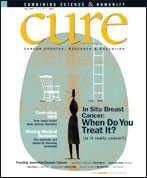Back in Action After DCIS
Treatment options for ductal carcinoma in situ (DCIS), a precursor to breast cancer.
When we get an ache or pain in our house, we wait a few days before we call the doctor. But when I felt a pain in my breast at 40 years old, my husband and I didn’t want to wait that long. Neither did the doctor who saw me first thing that Monday morning. Nor the radiologist who saw me that afternoon.
There was no tumor. I had microcalcifications. My left breast was scattered with white particles dotting the darkness. My right breast was smeared white. Eventually it was determined by my doctor that I had ductal carcinoma in situ (DCIS), which was described to me as a precursor to breast cancer that, if left untreated, might mature into invasive breast cancer. Even though it was DCIS, I still referred to it as breast cancer. Why? Because it was close enough, similar in treatment and much easier to explain.
Based on the prognostic score I received, my right breast was high risk and my left breast was low risk. Since my microcalcifications were so scattered, a mastectomy to remove all the breast tissue and the nipple was considered the best option. Statistically, 99 percent of the women who treat DCIS with a mastectomy do not get it again. My right breast clearly needed a mastectomy based on my high prognostic score. We could wait on my low-scoring left breast. But did I want to wait and wonder if the left breast would become cancerous? And what if it did? I didn’t want another trauma for my whole family to endure.
Call it what you want, I attributed the loss of my breasts to breast cancer, regardless of a DCIS classification. Fortunately, the DCIS had not spread and I wouldn’t need chemotherapy or radiation. After surgery and breast reconstruction, I just had to heal.
Eventually I got back in action, but I defied statistics. At 44, I was diagnosed with invasive breast cancer in both breasts. I became part of the 1 percent. Having invasive breast cancer didn’t feel different from having DCIS. Instead, it was more like breast cancer round two. I ended up having additional surgeries as well as chemotherapy and radiation.
I am nearly a year past the last of my surgeries and treatments. I made it out of round two flat-chested and healing nicely. I’m getting back in action.
--Nancy Reuben Greenfield is the author of the illustrated children’s book When Mommy Had A Mastectomy (Bartleby Press 2005, www.mommyhadamastectomy.com).
